Types of Open Source Software Solutions
Open-source software (OSS) has become the foundation of today’s technology ecosystem. Because its source code is public, anyone can view, modify, and redistribute it — promoting collaboration, transparency, and innovation.
This article explores the main types of open-source software solutions, complete with examples and practical uses across industries.
Operating Systems
Open-source operating systems give users complete control over how computers and servers function. Their flexibility, performance, and security make them the backbone of the internet.
Examples:
Linux distributions (Ubuntu, Fedora, Debian, Arch Linux), BSD systems (FreeBSD, OpenBSD, NetBSD), and Android (based on the Linux kernel).
Purpose:
Run applications, manage hardware, and power everything from personal computers to data centers.
Web Servers
Open-source web servers dominate the internet due to their speed, stability, and scalability.
Examples: Apache HTTP Server, NGINX, OpenLiteSpeed, Caddy.
Purpose: Host and deliver websites, manage HTTP requests, and handle millions of connections efficiently.
Databases
Open-source databases manage and store information efficiently while offering flexibility and cost savings compared to proprietary solutions.
Examples:
Relational databases (MySQL, PostgreSQL, MariaDB, SQLite) and NoSQL databases (MongoDB, Cassandra, CouchDB, Redis).
Purpose:
Store and query structured or unstructured data for applications, analytics, and websites.
Development Tools and Programming Languages
Most modern software development relies on open-source tools, languages, and environments.
Examples:
Editors and IDEs (Visual Studio Code, Eclipse, NetBeans, Atom), compilers and interpreters (GCC, Clang, Python, Ruby), and version control systems (Git, Mercurial, Subversion).
Purpose:
Enable developers to write, compile, test, and collaborate on software efficiently.
Desktop Applications
Open-source desktop applications provide free and customizable alternatives to commercial software.
Examples:
Office suites (LibreOffice, OnlyOffice, Apache OpenOffice), browsers (Mozilla Firefox, Chromium, Brave), design and graphics tools (GIMP, Inkscape, Krita, Blender), and media players (VLC, Audacity).
Purpose:
Boost productivity, creativity, and entertainment without licensing costs.
Cloud and Virtualization Platforms
These open-source systems are used to manage virtual machines, containers, and cloud infrastructure.
Examples:
Containerization (Docker, Podman, Kubernetes), virtualization (KVM, Xen, VirtualBox), and cloud management (OpenStack, CloudStack).
Purpose:
Build and manage private or public clouds, automate deployment, and scale applications seamlessly.
Security and Networking Tools
Open-source security tools provide transparency and power for protecting systems and analyzing networks.
Examples:
Network monitoring (Wireshark, Snort, pfSense), penetration testing (Kali Linux, Metasploit Framework), and encryption and privacy tools (OpenSSL, VeraCrypt, OpenVPN).
Purpose:
Detect vulnerabilities, secure communications, and protect sensitive data.
Content Management Systems (CMS)
CMS platforms make it easy to build, manage, and publish websites without deep coding knowledge.
Examples: WordPress, Drupal, Joomla, Ghost.
Purpose: Create blogs, corporate websites, and e-commerce platforms easily.
Collaboration and Communication Tools
As remote work grows, open-source collaboration software has become essential for team communication and project management.
Examples:
Messaging and collaboration tools (Mattermost, Rocket.Chat, Zulip), project management systems (Redmine, Taiga, OpenProject), and video conferencing platforms (Jitsi Meet, BigBlueButton).
Purpose:
Enable real-time communication, file sharing, and teamwork.
Enterprise and Business Software
Open-source enterprise solutions offer powerful alternatives to costly proprietary business tools.
Examples:
ERP systems (Odoo, ERPNext, Dolibarr), CRM platforms (SuiteCRM, EspoCRM, YetiForce), and e-commerce solutions (Magento Open Source, PrestaShop, OpenCart).
Purpose:
Automate and streamline business processes like sales, accounting, and logistics.
Scientific, Data, and AI Tools
Open-source software drives modern research, data analytics, and artificial intelligence.
Examples:
Data science tools (R, Jupyter Notebook, Pandas, NumPy), machine learning frameworks (TensorFlow, PyTorch, Scikit-learn), and visualization tools (Matplotlib, Plotly).
Purpose:
Process large datasets, train AI models, and visualize results effectively.
Game Development Tools
Game developers benefit from open-source engines and frameworks that allow full creative control.
Examples:
Game engines (Godot, OpenRA, Panda3D), 3D tools (Blender), and frameworks (Phaser).
Purpose:
Design and develop cross-platform games without expensive licenses.
Education and e-Learning Platforms
Open-source learning platforms support digital education for schools, universities, and online courses.
Examples: Moodle, Canvas LMS, Open edX, JupyterHub.
Purpose: Deliver online learning experiences, manage courses, and facilitate collaboration between teachers and students.
System Administration Tools
System administrators rely on open-source tools to manage servers and automate workflows.
Examples:
Automation tools (Ansible, Puppet, Chef), monitoring tools (Nagios, Zabbix, Prometheus, Grafana), and backup systems (Bacula, Duplicati, Restic).
Purpose:
Simplify server management, monitoring, and maintenance tasks.
Open Source Libraries and Frameworks
Libraries and frameworks accelerate software development by providing reusable components.
Examples:
Web frameworks (Django, Laravel, Ruby on Rails, Express.js), frontend frameworks (React, Angular, Vue.js, Svelte), and libraries (OpenCV, Boost, TensorFlow).
Purpose:
Provide pre-built code and structure for faster, more efficient software creation.
Conclusion
Open-source software solutions power nearly every aspect of modern computing — from operating systems to artificial intelligence.
Key benefits of open source include:
• Transparency — the code is open for anyone to inspect or audit.
• Flexibility — fully customizable to suit any use case.
• Community support — constantly updated and improved by global contributors.
• Cost-effectiveness — free to use, reducing licensing and operational costs.
In today’s world, open source is not just an alternative — it’s the driving force of innovation, collaboration, and technological progress.

